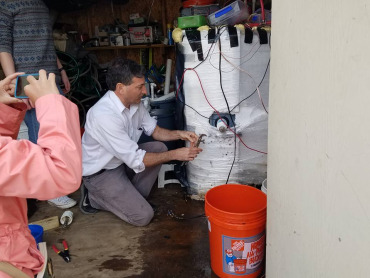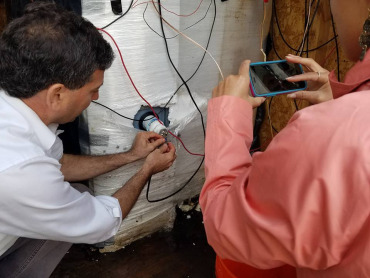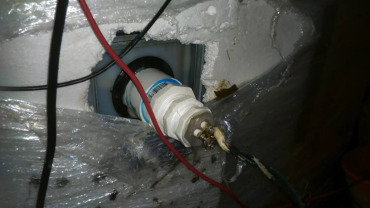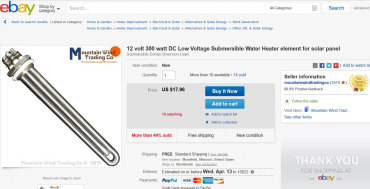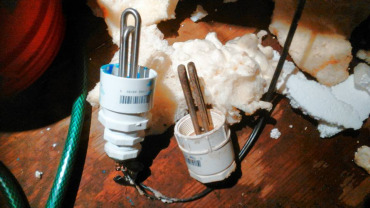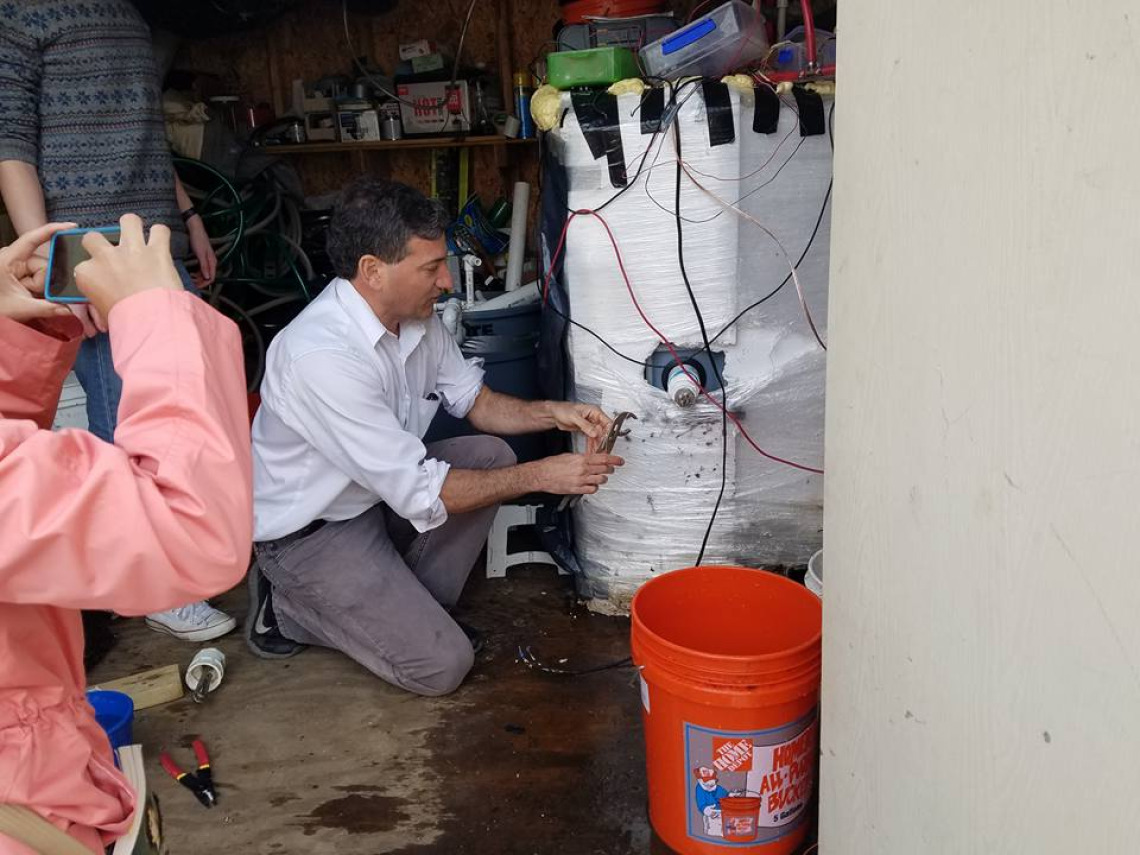
The Solar CITIES curriculum is evolving, challenging students around the world to add to the pool of citizen science exploring applied microbiology and engineering to make a better world.
Our first capstone project challenge addresses a vital need for the small biogas movement:
HOW DO WE BEST HEAT OUR DIGESTERS FOR MAXIMUM PERFORMANCE AND YEAR LONG OPERATION, PARTICULARLY IN TEMPERATE CLIMATES?
What we need from you now is performance data on the use of various heating options.
The first project is to find out the effectiveness of a standard 300 watt DC Heating element (normally used to heat water tanks for livestock or as a dump load for wind energy systems) in heating a 275 gallon (1000 liter) IBC tank digester.
Our own research has shown that it is more effective to put the heating element in the middle of the digester where there is clear slurry. We originally put it in the most convenient location -- screwed on to the valve at the bottom of the IBC tank, because hot water rises. But we found that the sludge layer that accumulates there clogs up and clumps around the heating element and impedes heat flow (it basically just bakes the sludge around the coil). So now we go into the middle of the tank where there is clear liquid slurry. And we successfully use a 2 inch uniseal to insert it. The heating element (which has a 1 inch screw thread) screws into a 1 inch to 2 inch female threaded adapter which then goes into a 2 inch coupling and short length of pipe that allows the heating element to portrude. This is then shoved into the uniseal. Indications are that it holds water well and does not leak.
We hook our heating coil up to two 100 watt solar panels in parallel (you can also try series) giving us 21 Volts open circuit but a maximum of 100 watts. We do this because we want more current going through the coil (higher amperage assumedly releases more heat). We started with a 60 watt coil but felt that we should have the ability to output more than 60 watts given that we have a 100 watts to play with. Since there are not coils between 60 and 300 that we could find we chose the 300 watt version. (Note that to use them you have to remove one of the two connection bars the unit comes with and make sure that you create a path for electrons through one of the coils out to the terminal that is connected by the remaining connection bar through the other coil and out the other terminal.)
What we need from YOU, citizen scientists, is the following:
1) We need to know how long it takes to heat a 5 gallon (30 liter) bucket of water from 15 C to 30 C (i.e. normal ground water temperature to reasonable digester temperature) using a 300 watt coil hooked to a single 100 watt PV panel.
This is a reasonably priced experiment in materials cost and from there we can manipulate variables and extrapolate.
Materials you need:
1) 1 100 Watt Solar Panel
[[{"fid":"1539","view_mode":"content_medium","fields":{"format":"content_medium","field_file_image_alt_text[und][0][value]":"Renogy 100 Watt Solar Panel","field_file_image_title_text[und][0][value]":"Renogy 100 Watt Solar Panel","field_folder[und]":"123"},"type":"media","attributes":{"alt":"Renogy 100 Watt Solar Panel","title":"Renogy 100 Watt Solar Panel","height":"272","width":"400","class":"media-element file-content-medium"}}]]
(You can get the Renogy kit from Amazon.com or many other suppliers for about $150. The panel itself is $132 as of 4/6/2016 while the kit with mounting brackets and charge controller (recommended) is $159).
You can't really go wrong owning a 100 watt solar panel. When the experiments are done you can use it to charge emergency back up batteries in case of power failure. Everyone should have at least one. In fact, you can run your lights and computer off of a 100 watt panel with a uninterruptable power supply and be "off-grid" most of the time.
2) A 300 Watt DC Heating element.
[[{"fid":"1540","view_mode":"content_medium","fields":{"format":"content_medium","field_file_image_alt_text[und][0][value]":"300 watt DC heating element","field_file_image_title_text[und][0][value]":"300 watt DC heating element","field_folder[und]":"123"},"type":"media","attributes":{"alt":"300 watt DC heating element","title":"300 watt DC heating element","height":"204","width":"400","class":"media-element file-content-medium"}}]]
This piece of kit is only $18 so it won't break your bank. It is the heart of the experiment.
3) Wires, 14 gauge, to connect solar panel to the heating coil.
4) A simple in line toggle switch so you can turn the heating coil off when you want to work on it.
5) A 5 gallon paint bucket with a lid.
6) A 2" uniseal (order from http://www.aussieglobe.com/2-Uniseal-U200.html)
7) A 1 inch female threaded to 2 inch PVC adapter
8) A 2 inch coupling
9) a piece of 2 inch pipe six inches or so long.
10) Teflon tape.
11) PVC cement
11) A three inch hole saw
12) Temperature probe/thermometer
Procedure:
Construction:
Drill a three inch hole in the middle of your bucket.
Assemble the heater coil insertion tube by gluing the 1 inch to 2 inch adapter to the 2 inch coupling and gluing the 6 inch length of pipe to the coupling.
Screw the heating element into the 1 inch threaded hole (use teflon on the threads and tighten with a wrench).
Put the uniseal into the bucket (it helps to put grease on the outside of the uniseal for a good seal.)
Sand the edges of the pipe down smooth (cut to taper the edges if you can and then sand) and then soap the pipe and shove it into the uniseal as ar as you can, until the coupling hits the uniseal and stops.
Fill the bucket with water.
Hook the solar panel wires to the heating coil (put a switch in the positive wire so you can interrupt the current when you want to).
(Make sure if you have a 300 watt heating element that has 4 terminals with connection bridges that you remove one of the connection bridges and hook the wires up to the two terminal without a connection bridge. We will post pictures once available. If questions, write and ask us on https://www.facebook.com/groups/methanogens/)
Data 1
Record the initial temperature.
Set the solar panel in the sun and record the time.
Record the temperature of the water at the end of the day.
Data 2
Insulate the bucket in a styrofoam box to keep heat in.
Leave the panel in a sunny place and record the temperature in the bucket each day at the start of the day from 10 am and again at the end of the day at 5 pm.
Keep track of these measurements in an excel spreadsheet and find out how many days it takes to get the bucket to 30 C.
The more insulated the bucket the better. You should try to keep the bucket indoors where it won't cool off as fast.
Data 3
Hook an arduino microcontroller with an ds18b20 waterproof temperature probe and an SD card reader to the tank and get longitudinal temperature data that you can graph. If you are more ambitious, hook up a light sensor to the arduino too so you can correlate with sunlight.
This citizen science project is critical so we can determine how much solar input we need to get our digesters hot enough to perform well.
You can also experiment with 60 watt coils and compare them to the 100 watt coils. If you have an IBC tank, substitute that for the 5 gallon bucket; after all, that is the practical size of a digester so that is really what we want to know: how long does it take to heat with a single coil? You can also add solar panels to your experiment and compare. Eventually we may hit upon the right number of panels and coils to keep the temperatures high enough to work all year long. Your input is very valuable to the movement.
Thanks for being part of the Solar CITIES (r)evolution!

